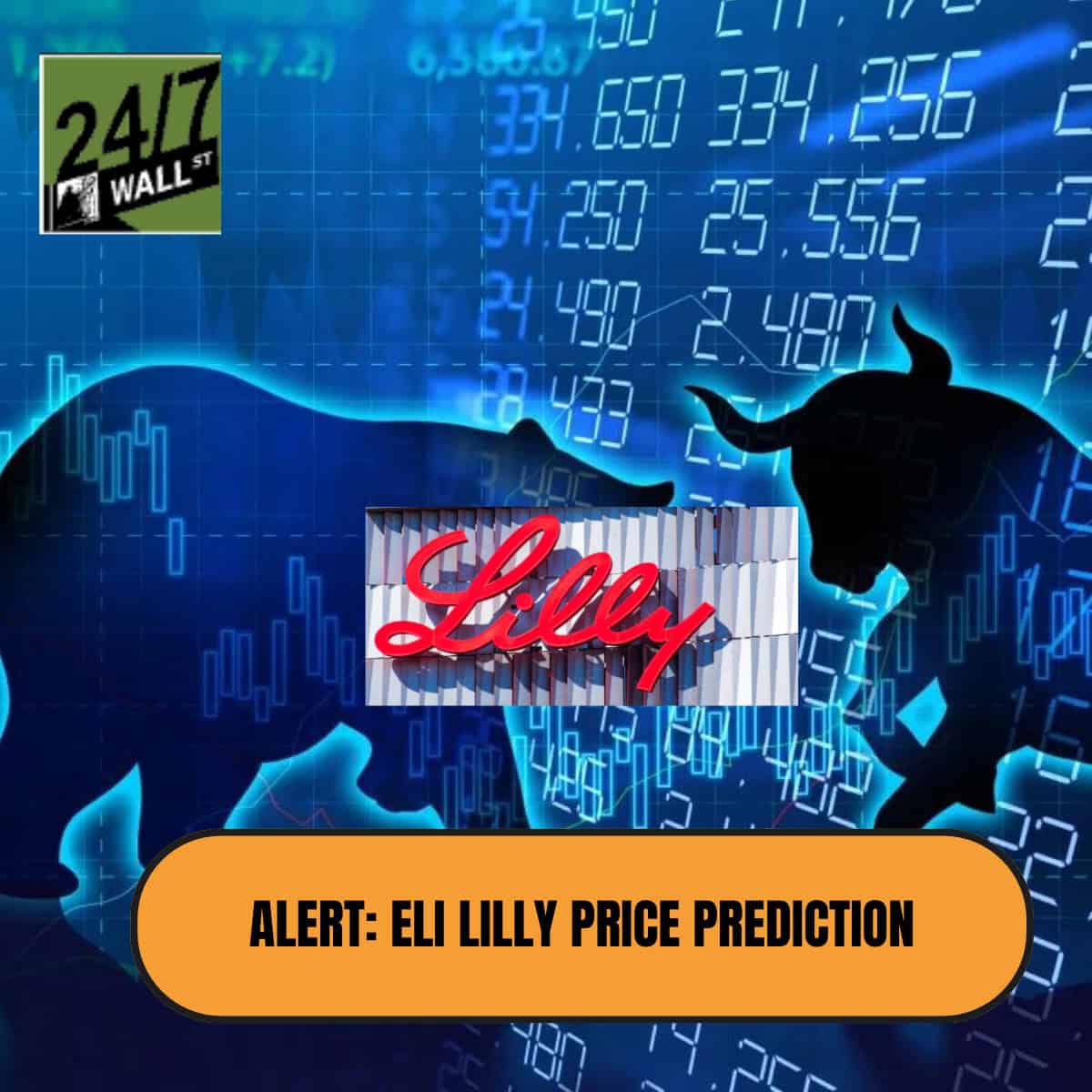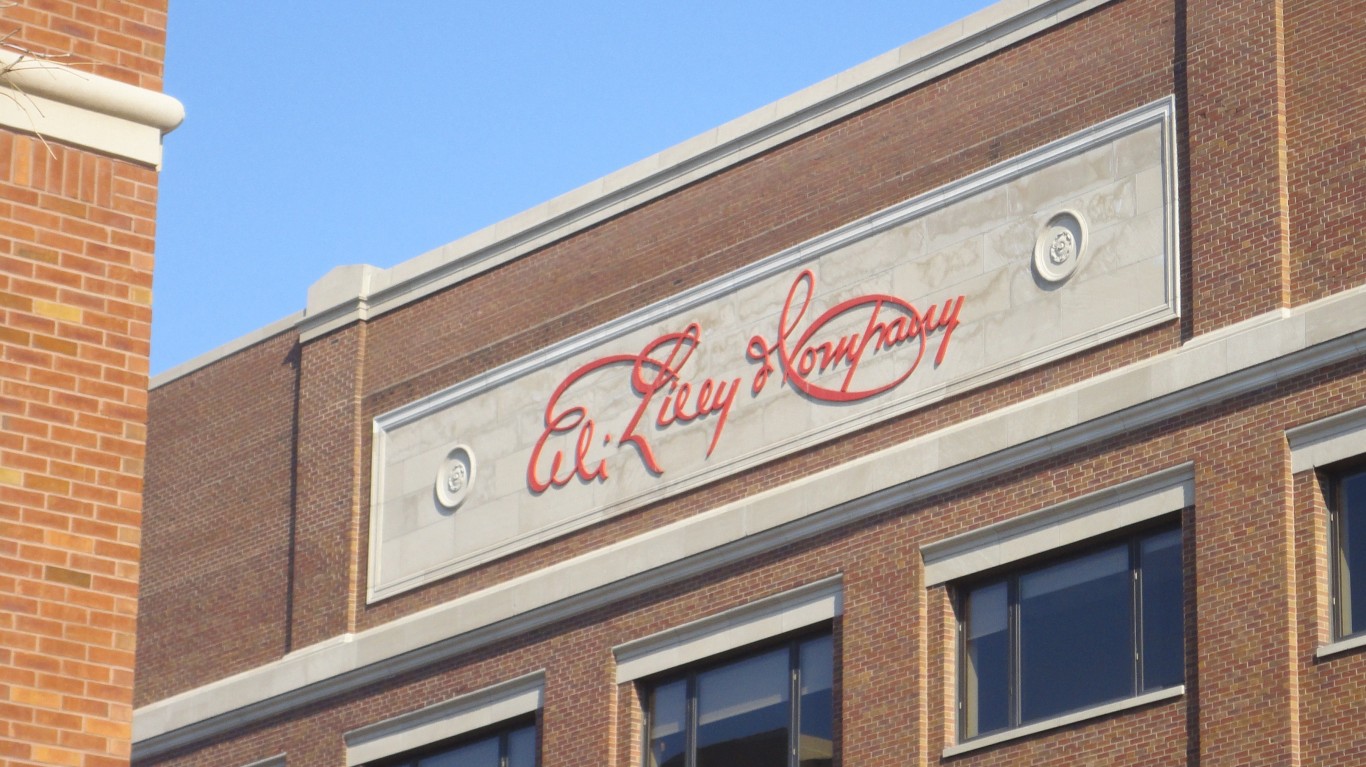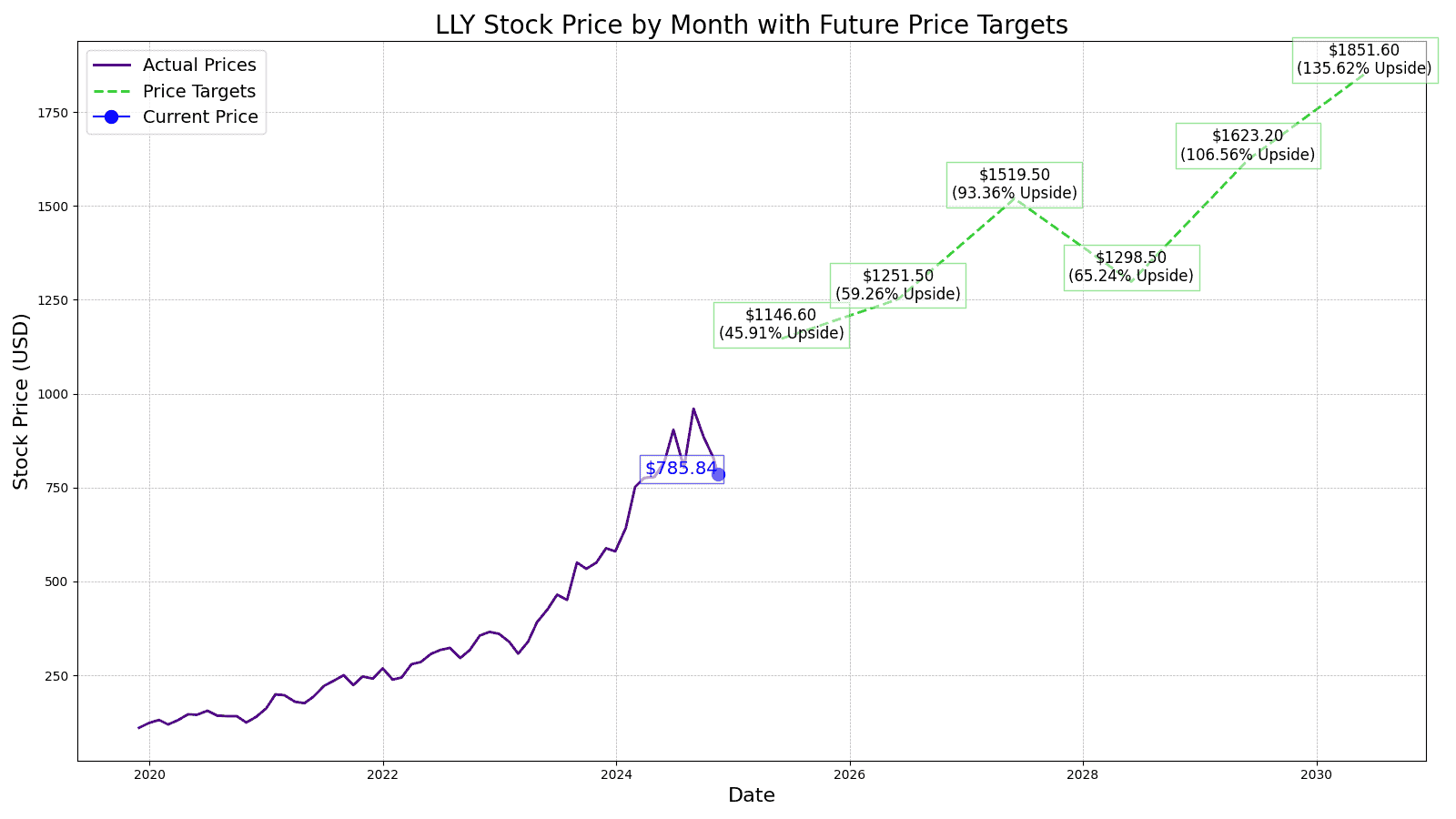Investing
Eli Lilly (LLY) Stock Price Prediction and Forecast 2025-2030

Published:
Last Updated:

Since the start of 2020, Eli Lilly’s (NYSE: LLY) stock price chart has been straight up and to the right, up 494.39% and currently trading at $785.84.
The company has been around since 1876 and the stock didn’t go public until 1952 but in the last 4 years, Eli Lilly went from a $100 billion market capitalization to $740 billion today, which also makes it a potential stock split stock.
However, as investors, we care about the stock price years down the line and what Eli Lilly will do in the next 3 to 5 years and beyond.
That is why 24/7 Wall Street looks at projected revenue and net income to give you our best estimate of future stock prices from 2025 to 2030.
Other “experts” look at past growth rates and assign future stock prices to those past numbers. However, we will walk you through our assumptions and give you the key drivers we see propelling Eli Lilly’s stock in the future.

11/15/2024
Eli Lilly is taking legal action against the Department of Health and Human Services. The lawsuit seeks a court order that will let the company reduce the discounts they give to hospitals for their drugs.
11/14/2024
Eli Lilly’s weight-loss drug, tirzepatide, has shown promising results in preventing diabetes. After three years of weekly injections, nearly 99% of patients remained diabetes-free. This suggests that for every nine patients treated with tirzepatide, one new case of diabetes could be prevented.
11/12/2024
Eli Lilly’s CEO, Dave Ricks, has been named the recipient of the 2024 August M. Watanabe Life Sciences Champion of the Year Award by BioCrossroads. Under Ricks’ leadership, the company has invested billions of dollars in research and development to address critical health challenges, particularly in areas like oncology, obesity, immunology, and neurodegenerative diseases.
11/11/2024
Susan McGowan, a 58-year-old nurse from Scotland, tragically passed away after taking two doses of tirzepatide, a weight-loss drug manufactured by Eli Lilly. McGowan experienced multiple organ failure, pancreatitis, and septic shock a few days after taking the medication. This is believed to be the first such death in the U.K. officially linked to the medication.
11/8/2024
There is a strong bullish sentiment surrounding Eli Lilly, as seen by the increase in call option trading volume. This surge, particularly in the 820 and 830 strike calls expiring today, suggests that traders are anticipating a potential upside in the stock price.
11/7/2024
After a six-day losing streak, Eli Lilly’s stock is finally rebounding today. While the stock is still down 14% over the past month, it’s still outperforming the broader market, with a year-to-date gain of over 35% compared to the S&P 500’s 24%.
11/5/2024
Eli Lilly has announced that the company will present data from studies of Jaypirca (pirtobrutinib) at the 66th American Society of Hematology (ASH) Annual Meeting in San Diego. The meeting and exposition will be held from December 7th through the 10th.
11/4/2024
Deutsche Bank analyst James Shin has lowered his price target slightly for Eli Lilly, reducing it from $1,025 to $1,015. However, he maintains a “Buy” rating on the stock.
10/31/2024
Eli Lilly released its quarterly earnings report, showcasing strong growth in Q3 and a total revenue rising 42% year-over-year.
10/29/2024
Eli Lilly has received approval to start selling its weight loss drug, Mounjaro, in Hong Kong as early as the end of this year.
10/28/2024
Eli Lilly will release its third-quarter results this Wednesday. Investors are keen to see how the company has performed, particularly regarding Mounjtaro and Zepbound. Analysts expect Eli Lilly to report $12.1 billion in sales and $1.45 in adjusted earnings per share for the quarter.
10/25/2024
Eli Lilly announced positive results from its Phase 3b study of Ebglyss, which focused on patients with moderate-to-severe atopic dermatitis. Patients had been previously treated with Dupixent with little success. However, the results of this latest Ebglyss study show that it was effective in improving skin and itch symptoms, particularly in challenging areas like the face and hands.
How did Eli Lilly’s stock price soar so much in the past few years? Let’s take a look at the numbers:
| Share Price | Revenues* | Net Income* | |
| 2016 | $80.36 | $21.22 | $2.74 |
| 2017 | $77.55 | $19.94 | ($0.21) |
| 2018 | $122.13 | $21.49 | $3.23 |
| 2019 | $140.83 | $22.32 | $8.32 |
| 2020 | $206.46 | $24.54 | $6.19 |
| 2021 | $238.31 | $28.32 | $5.58 |
| 2022 | 329.07 | $28.54 | $6.25 |
| 2023 | $745.91 | $34.12 | $5.24 |
*Revenue and Net Income in Billions
Since 2016, Eli Lilly’s revenue grew by 60% but income grew by 91%. Typically you wouldn’t expect a company growing at its top line by 7% annually to see an 828% increase in share price, however, investor sentiment for the next line of drugs front ran the stock price.
For example, in 2016 Eli Lilly was trading 13 times the trailing 12 months earnings and the market has increased its valuation each year and currently trades at a 125 times earnings multiple.
This raises the valid question, is Eli Lilly overvalued or will future revenues make up for the expensive valuation?

The current Wall Street consensus 1-year price target of Eli Lilly stock is $1030.00, which is 31.07% higher than today’s price of $785.84. Of the 26 analysts covering Eli Lilly stock, the current rating is 1.67 or “Outperform” with 1-year price targets as high as $1,100 and as low as $540.00.
24/7 Wall Street sets its 1-year price target at $1,040. Taking a look at the sum of its parts, we see Eli Lilly’s vertices valued as follows:
| Endocrinology | $735/ share |
| Oncology | $122/ Share |
| Cardiovascular | $4/ Share |
| Neuroscience | $16/ Share |
| Immunology | $38/ Share |
| Others and Pipeline | $110/ Share |
| Cash | $17/ Share |
Valuing Eli Lilly’s stock price for the coming years, we will take a look at expected revenue and net income and give our best estimate of the market value of the company by assigning a price-to-earnings multiple.
| Revenue | Net Income | EPS | |
| 2025 | $52.8 | $17.29 | 19.11 |
| 2026 | $62.5 | $22.49 | 25.03 |
| 2027 | $70.87 | $27.12 | 30.39 |
| 2028 | $80.68 | $32.2 | 25.97 |
| 2029 | $87.99 | $36.45 | 40.58 |
| 2030 | $96.67 | $41.12 | 46.29 |
*Revenue and net income reported in billions

We expect Eli Lilly’s P/E ratio in 2025 to be 60 with an EPS of $19.11, resulting in a price target of $1140.00 This prediction is based on strong revenue growth of 18.37% to $52.80 billion and net income expansion to $17.29 billion, continuing the upward trajectory from previous years.
For 2026, we anticipate a P/E ratio of 50 with an EPS of $25.03, leading to a price target of $1250.00. This reflects significant revenue growth of 18.37% to $62.50 billion and an increase in net income to $22.49 billion, driving higher earnings per share.
Heading into 2027, we project the P/E ratio to remain at 50, with EPS increasing to $30.39. This results in a price target of $1520.00. Continued revenue growth of 13.39% to $70.87 billion and net income expansion to $27.12 billion justifies this substantial increase in stock price.
With an EPS of $25.97 and a P/E ratio of 50 in 2028, we forecast the stock price to be $1300.00. A slight dip in EPS growth is expected, but sustained strong performance in net income to $32.20 billion and revenue growth of 13.84% to $80.68 billion keeps the stock highly valued.
By 2029, we estimate Eli Lilly’s EPS to rise to $40.58, with the P/E ratio adjusting to 40. This gives us a price target of $1623.00. The continuous revenue growth of 9.06% to $87.99 billion and net income expansion to $36.45 billion supports this higher valuation.
Price Target: $1850.00
Upside: 135.42%
By 2030, we estimate Eli Lilly’s EPS to rise to $46.29, with the P/E ratio adjusting to 40. This gives us a price target of $1850.00. The continuous revenue growth of 9.86% to $96.67 billion and net income expansion to $41.12 billion supports this higher valuation.
| Year | Price Target | % Change From Current Price |
|---|---|---|
| 2025 | $1140.00 | Upside of 45.07% |
| 2026 | $1250.00 | Upside of 59.07% |
| 2027 | $1520.00 | Upside of 93.42% |
| 2028 | $1300.00 | Upside of 65.43% |
| 2029 | $1623.00 | Upside of 106.53% |
| 2030 | $1850.00 | Upside of 135.42% |
Let’s face it: If your money is just sitting in a checking account, you’re losing value every single day. With most checking accounts offering little to no interest, the cash you worked so hard to save is gradually being eroded by inflation.
However, by moving that money into a high-yield savings account, you can put your cash to work, growing steadily with little to no effort on your part. In just a few clicks, you can set up a high-yield savings account and start earning interest immediately.
There are plenty of reputable banks and online platforms that offer competitive rates, and many of them come with zero fees and no minimum balance requirements. Click here to see if you’re earning the best possible rate on your money!
Thank you for reading! Have some feedback for us?
Contact the 24/7 Wall St. editorial team.